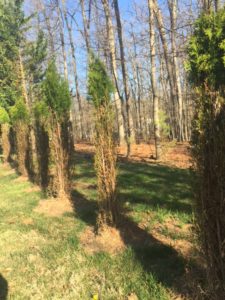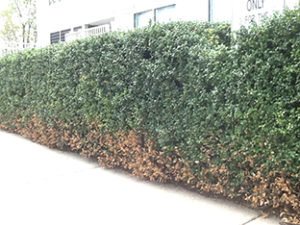 Winter tree care helps ensure your trees survive the freezing temperatures and extreme weather. Below you will find what winter tree care you should be doing from December through February.
Winter tree care helps ensure your trees survive the freezing temperatures and extreme weather. Below you will find what winter tree care you should be doing from December through February.
Spray Anti-Desiccants on Evergreens:
Most of the negative effects of winter stem from the fact that trees and shrubs lose moisture through their pores which are located on their leaves/needles. During the winter months, the dry air and wind accelerate this effect, leading to leaves increasing their water demand from the roots in order to survive.
However, the root system usually has a hard time keeping up with the leaves’ demands. In result, the tree leaves and needles eventually turn brown and die. This cycle is called winter burn, or winter desiccation.
Adding anti-desiccant treatments to your winter tree care plan can solve this destructive cycle. Anti-desiccants coat the upper and lower foliage in a protective wax coating reducing the moisture lost through the leaves. Similar to the moisturizers, lotions, and humidifiers we use to keep our skin hydrated in the winter, anti-desiccants provide trees & shrubs with the protection they need to flourish during winter instead of fighting to survive. This means no more browning and dying evergreens.
Prune While The Tree Is Dormant:
We’re often asked whether tree trimming can be performed in the winter. The truth is, it is actually the optimal time to prune trees. Although trees and shrubs are generally forgotten during winter, the dormant season is the best time to trim and inspect your trees.
As an example, dead branches and structural issues in large shade trees can be easily identified and properly pruned in the cold months. Branch defects and structural issues are also plainly visible with the absence of leaves. Together, this makes it easier to remove branches.
Furthermore, when selective tree pruning of live branches is necessary, the dormant season is the best time of year for such actions to take place. On the aesthetics side, pruning in the dormant season will stimulate a burst of new growth in the spring. Learn more about tree trimming and schedule a tree trimming evaluation with a certified arborist today by calling 703.573.3029 or by booking online.
Wrap Your Young & Newly Planted Trees:
Sun scald is winter damage that is commonly seen on young trees, newly planted trees, and thin-barked trees (cherry, crabapple, honey locust, linden, maple, mountain ash, plum). Sun scald caused the tree bark to dry and crack. The University of Minnesota explains that “On cold winter days, the sun heats up bark to the point where cambial activity is stimulated. When the sun is blocked by a cloud, hill, or building, bark temperature drops rapidly, killing the active tissue” creating sun scald.
To combat this add tree wrapping to your winter tree care. We suggest only wrapping susceptible trees. You can purchase burlap tree wrap and follow simple application tutorials online to protect your trees in winter.
Need Help With Winter Tree Care?
Or Call 703.573.3029

Prevent Deer Damage:
Deer browsing and damage can be costly, unsightly, and even pose a health risk. During the harsh winter months when the food supply is low, deer will feast on your plants and tear apart your gardens. In some cases this damage can have long term effects and disfigure your landscape.
Annually, this damage exceeds $2 billion nationwide. If that wasn’t bad enough, they also bring deadly disease carrying travelers into your yard threatening the safety of your loved ones. Which is why you should add a deer program to your winter tree care plan.
Fortunately, because deer go after the best tasting & easily accessible foliage, simple precautions can be take to deter them from your property. However; this means if your neighbors have a deer protection program and your property doesn’t, your trees & shrubs will be the most appealing to hungry deer.
RTEC offers a program that provides protection for your plants and trees on your yard. Get our Deer Deterrent & Management Program today by calling 703.573.3029 or scheduling an appointment via our online calendar.
Remove Heavy Snow From Branches:
Although light snow typically won’t do damage to tree branches, there is an issue when snow storms strike. When the snow starts to pile up, you need to take action to keep branches from breaking. Your first instinct may be to shake the limbs to get the snow off, but this can actually cause more damage by snapping the brittle winter branches of the trees.
Instead, gently brush the snow off of the tree in upward strokes. To reach higher in the tree, GENTLY use a broom in an upward sweeping motion to remove snow. Make sure to focus on Evergreens; snow easily piles up on these trees because of their needles. Adding this simple step to your winter tree care plan can prevent snapping branches.

Avoid Rock Salt Or Ice Melts:
The salt used to melt ice and snow on the roads and walkways, typically sodium chloride, can have a devastating impact when it comes into contact with trees and shrubs. When the road salt enters the soil water can be pulled out of the tree roots dehydrating the tree. Salt caught up in the air can also coat the tree pulling the water out of the needles, buds, and branches further dehydrating the tree/shrub as well.
If you have control over what kind of salt your tree is exposed to, opt for Magnesium chloride instead. Using this type of salt on your driveway and walkways can keep your tree from experiencing damage from the typical sodium chloride. If your trees are close to the road and will be exposed to sodium chloride all is not lost. Remove the salt you can see and make sure to provide your tree with enough water to flush out the soil and its system.
An Anti-Desiccant spray, which we talked about above, can help deter salt damage as well.
Inspect Trees Annually:
Winter is a great time to get your tree inspected for structural and safety issues. When leaves are off the tree, arborists can easily spot structural issues that could be or become dangerous. Arborists recommend trees be inspected annually so winter is a great time to check this task off your to do list.
Learn About:
